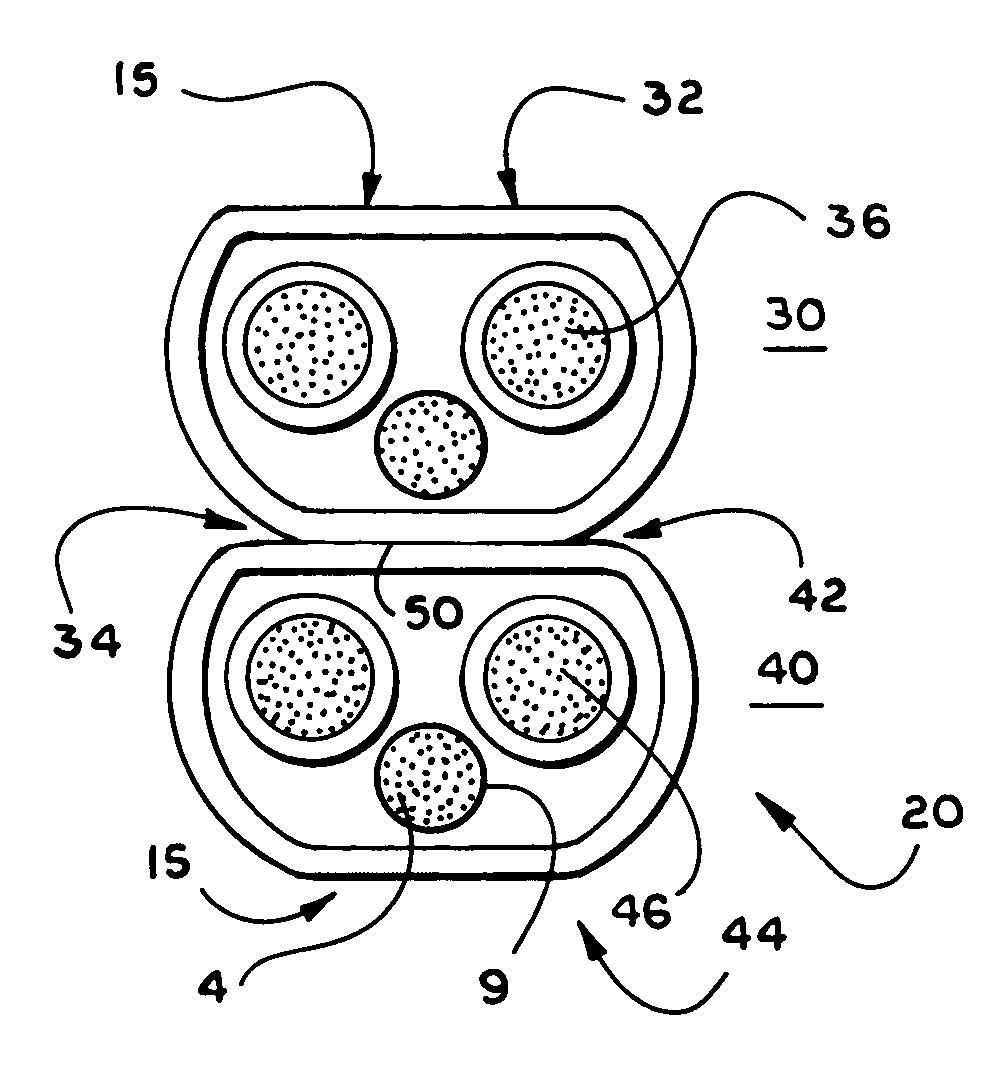Coupled building wire with lubricant coating
a technology of lubricant coating and building wire, which is applied in the direction of insulated conductors, cables, instruments, etc., can solve the problems of high friction coefficient on the exterior surface, unsatisfactory entanglement of two lengths of cables, and the burden of using multiple coils, so as to reduce the friction coefficient, reduce the amount of force, and reduce the friction coefficient
- Summary
- Abstract
- Description
- Claims
- Application Information
AI Technical Summary
Benefits of technology
Problems solved by technology
Method used
Image
Examples
first embodiment
[0030] With continuing reference to FIG. 2, in the present invention, the bottom surface 34 of the first length of NM cable 30 is coupled to the top surface 42 of the second length of NM cable 40 using a cementitious material 50 and at least the top surface 32 of the first length of NM cable 30 and at least the bottom surface 44 of the second length of NM cable 40 are at least partly covered with a lubricant coating 15. In accordance with this embodiment, the cementitious material 50 is applied to either the bottom surface 34 of the first length of NM cable 30 or to the top surface 42 of the second length of NM cable 40. The bottom surface 34 of the first length of NM cable 30 and the top surface 42 of the second length of NM cable 40 are then pressed together to form the coupled building wire 20. It will be appreciated that the cementitious material 50 may be any suitable cement-like substance such as PVC cement or the like.
second embodiment
[0031] With reference to FIG. 3, in the present invention, the bottom surface 34 of the first length of NM cable 30 is coupled to the top surface 42 of the second length of NM cable 40 using glue 60 and at least the top surface 32 of the first length of NM cable 30 and at least the bottom surface 44 of the second length of NM cable 40 are at least partly covered with a lubricant coating 15. In accordance with this embodiment, the glue 60 is applied to either the bottom surface 34 of the first length of NM cable 30 or to the top surface 42 of the second length of NM cable 40 as a non-continuous bead or as a continuous bead. The bottom surface 34 of the first length of NM cable 30 and the top surface 42 of the second length of NM cable 40 are then pressed together to form the coupled building wire 20. It will be appreciated that the glue 60 may be a soft glue or a hard glue.
third embodiment
[0032] With reference to FIG. 4, in the present invention, the bottom surface 34 of the first length of NM cable 30 is coupled to the top surface 42 of the second length of NM cable 40 using a webbing material 70 and at least the top surface 32 of the first length of NM cable 30 and at least the bottom surface 44 of the second length of NM cable 40 are at least partly covered with a lubricant coating 15. In accordance with this embodiment, an extrusion machine is employed to apply the webbing material 70 to the bottom surface 34 of the first length of NM cable 30 and the top surface 42 of the second length of NM cable 40. The bottom surface 34 of the first length of NM cable 30 and the top surface 42 of the second length of NM cable 40 are then pressed together to form the coupled building wire 20. It will be appreciated that the webbing material 70 may be any suitable substance such as polypropylene webbing or the like.
PUM
| Property | Measurement | Unit |
|---|---|---|
| length | aaaaa | aaaaa |
| force | aaaaa | aaaaa |
| lengths | aaaaa | aaaaa |
Abstract
Description
Claims
Application Information
 Login to View More
Login to View More - R&D
- Intellectual Property
- Life Sciences
- Materials
- Tech Scout
- Unparalleled Data Quality
- Higher Quality Content
- 60% Fewer Hallucinations
Browse by: Latest US Patents, China's latest patents, Technical Efficacy Thesaurus, Application Domain, Technology Topic, Popular Technical Reports.
© 2025 PatSnap. All rights reserved.Legal|Privacy policy|Modern Slavery Act Transparency Statement|Sitemap|About US| Contact US: help@patsnap.com



